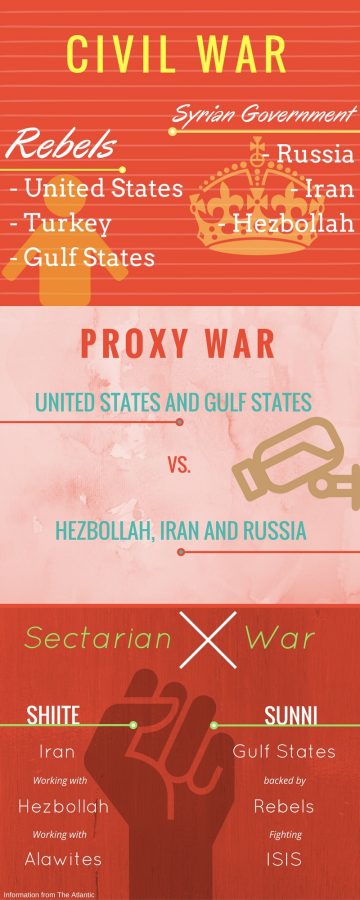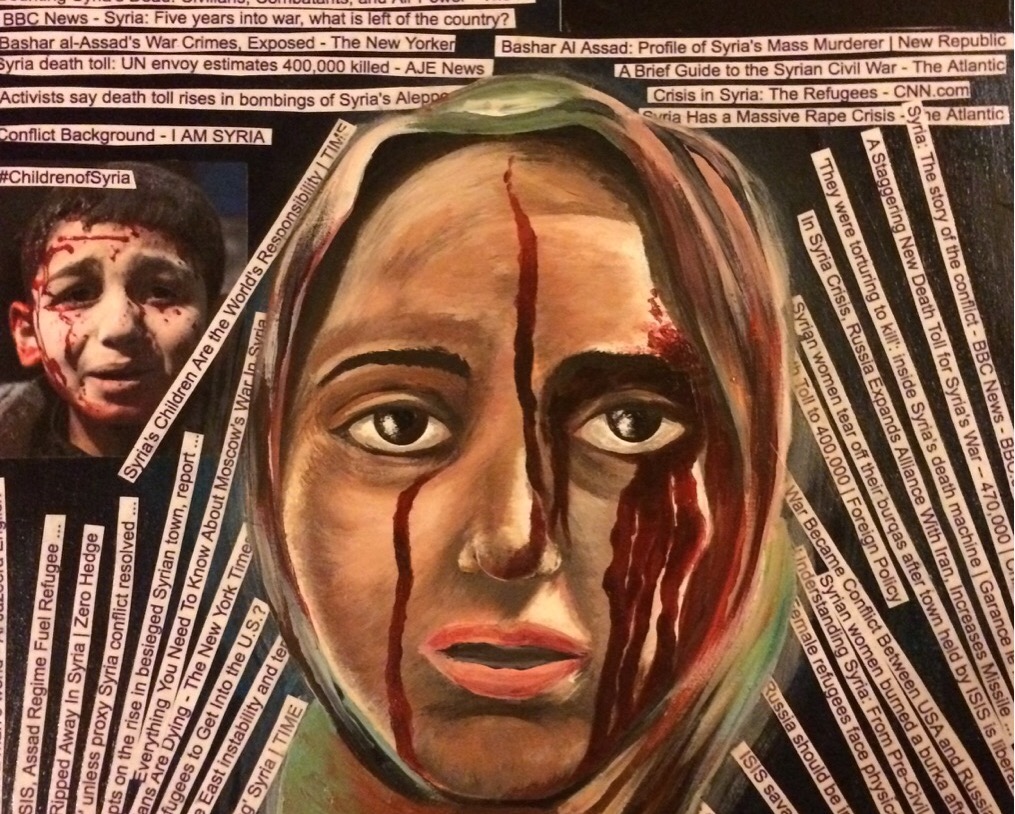Breaking down the Syrian Civil War
November 22, 2016
Lots of information has been circulating about the recent airstrikes in Syria, leaving cities like Aleppo in desperate need of humanitarian aid . Additionally, ongoing debates rage in Europe and America in regards to admitting more refugees into their country. Syrian President Bashar al-Assad considers president-elect Donald Trump a “natural ally” for the fight against terrorism in Syria, bringing the conflict closer to home. In order to understand current world affair, it is essential to understand what is happening in Syria, an ongoing-five-year conflict.
Here are the four main causes of the conflict:
1. The Boiling Pot Explodes
In March 2011, anti-government and pro-democracy protests escalated into a full-scale civil war in the city of Daara. After security forces opened fire on demonstrators, killing several people, the unrest triggered nationwide protests demanding President Bashar al-Assad’s resignation, who has been in office since 2000.
The government used harsh forces crush protesters, a tactic which only increased hostilities. By July 2011 BBC News reported hundreds of thousands of people taking to the streets across the country as protestors took up arms to defend themselves and later to expel security forces from their local areas. These rebels are now known as the Free Syrian Army.
The content of President Assad’s first address since the unrest dismayed the opposition, who had hoped that the president would reveal details of how he plans to reform the tightly policed state. Assad failed to meet any of the protester’s demands.
2. The War of Religion
The Syrian civil war has also into a battle of religion. There are many different religious groups involved in the Syrian conflict, mostly associated with Islam. These Islamic groups aim to reorder the government and society in accordance with the Islamic law, or Sharia.
These are perhaps the most important religious groups involved in the issue:
The Jihadists joined the Syrian rebel forces against Assad’s government. BBC News explains how Jihadists “see violent struggle as necessary to eradicate obstacles to restoring God’s rule on Earth and defending the Muslim community against infidels and apostates.” In other words, Jihadists follow the Quran in a strict form, imposing hostile beliefs on people who do not follow Islam.
Much of Jihadism’s main beliefs have influenced the Islamic State of Iraq and Syria, or ISIS. This has led many Jihadists to join the conflict with ISIS during the war. ISIS has since made no secret of its ultimate ambition of a global caliphate, which would be secured through a global war. ISIS also aims to continue “expanding” its existing hold over much of Syria and Iraq. The Islamic State has also seeked to overcome the Shiite “crescent” that emerged through the Middle East, which contributed to the initiation of the religious ‘war within the war’ in Syria.
The Hezbollah, which is another branch of Islam based on Shia beliefs, from Lebanon have publicly announced their military involvement in the Syrian war as an ally of President Assad, first for the the purpose of ‘the protection of Lebanese villages’ on the border with Syria, and later for the protection of Shia holy shrines.
According to CNN, Shiites, again, follow Islam based on Shia beliefs, and are a minority in Syria, have also came to support the Assad presidency because the Syrian government allowed them to build major shrines to the faith’s founders in Syrian cities. After all, president Assad is an Alawite, which is a minority religious group who follows the Shia Islamic beliefs.
The Sunni, the majority religious group in Syria, have indirectly fought the government but are rather fighting a sectarian war against the Shiites.

“Various Syrian rebel groups and foreign elements operating in Syria fall along the spectrum of religious ideology, and consider their aggregate effect upon the Islamification of the Syrian opposition,” the Institute for the Study of War said.
3. The Proxy War
The conflict has debatably been labeled as a “proxy war” due to its many opposing foreign sides. To simplify matters, Iran and Russia have supported the Alawite-led presidency in many different ways. Iran has provided the Syrian government with technical and financial support, as well as trained some combat troops. Russia has launched many air strikes targeting Assad’s opponents. As mentioned previously, the Syrian government has also enjoyed the support of Lebanon’s Shia Islamist Hezbollah movement, whose fighters have provided important battlefield support.
The United States and the gulf states have become the major opponents of these groups. America has provided much aid to the humanitarian cause as well nonlethal aid and arms to rebels.
“In Syria, the U.S. strongly objects to the Russian intervention — holding that it will only stoke conflict, further radicalize the opposition, and make eventual formation of a coalition government even less likely. Russia in turn sympathizes with President Bashar al-Assad’s view that the opposition are terrorists and must be eradicated. The U.S. and Russia deeply distrust each other’s motives in Syria, and cooperation is unlikely in the foreseeable future.” Cliff Kupchan, chairman of the global risk analysis firm Eurasia Group, said.
4. Devastating Outcomes for Syria
Throughout the ongoing armed conflict, more than 250,000 Syrians have lost their lives while 11 million Syrians have been forced from their homes, which is over half of the country’s population, according to BBC News.
The U.N. has made it clear it will need more than three billion dollars to help the 13.5 million people, including six million children who are in desperate need of humanitarian assistance inside Syria in 2016.
The OCHA (United Nations’ Office for the Coordination of Humanitarian Affairs) has announced that four out of five Syrians now live in poverty. Since the start of the crisis in 2011, life expectancy among Syrians has dropped by more than 20 years, while school attendance has dropped over 50 percent and the Syrian economy has dropped by more than 40 percent since 2011. Syria has seen reversals in all 12 Millennium Development Goal indicators.

Ingrid Solomon • Nov 30, 2016 at 3:30 am
Uma análise detalhada,clara é muito bem descrita da complexa situação dos conflitos .